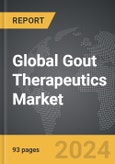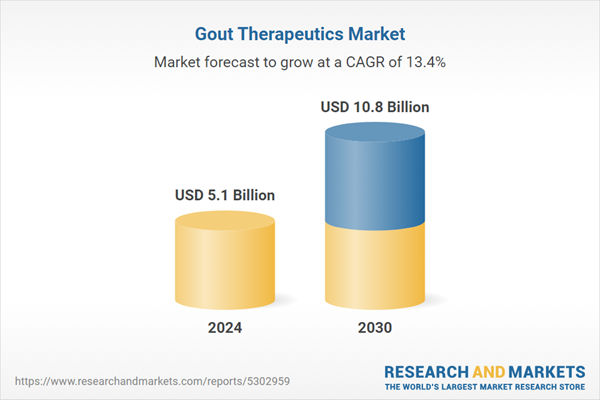The global market for Gout Therapeutics was valued at US$5.1 Billion in 2024 and is projected to reach US$10.8 Billion by 2030, growing at a CAGR of 13.4% from 2024 to 2030. This comprehensive report provides an in-depth analysis of market trends, drivers, and forecasts, helping you make informed business decisions. The report includes the most recent global tariff developments and how they impact the Gout Therapeutics market.
Segments: Type (NSAIDs, Urate-Lowering Agents, Colchicine, Corticosteroids); Disease Condition (Chronic Gout, Acute Gout).
Geographic Regions/Countries: World; United States; Canada; Japan; China; Europe (France; Germany; Italy; United Kingdom; Spain; Russia; and Rest of Europe); Asia-Pacific (Australia; India; South Korea; and Rest of Asia-Pacific); Latin America (Argentina; Brazil; Mexico; and Rest of Latin America); Middle East (Iran; Israel; Saudi Arabia; United Arab Emirates; and Rest of Middle East); and Africa.
The analysts continuously track trade developments worldwide, drawing insights from leading global economists and over 200 industry and policy institutions, including think tanks, trade organizations, and national economic advisory bodies. This intelligence is integrated into forecasting models to provide timely, data-driven analysis of emerging risks and opportunities.
Global Gout Therapeutics Market - Key Trends and Drivers Summarized
How Is the Gout Therapeutics Market Evolving with the Rise in Chronic Diseases?
Gout is a chronic form of arthritis caused by elevated levels of uric acid in the blood, leading to the formation of painful crystals in joints. Gout therapeutics are essential in managing this condition, which is becoming increasingly common due to lifestyle factors such as poor diet, obesity, and the aging population. The rising prevalence of gout is prompting a growing demand for effective therapies that can manage both acute flare-ups and long-term uric acid levels. Traditional treatments like nonsteroidal anti-inflammatory drugs (NSAIDs), corticosteroids, and colchicine are still widely used, but there is a significant shift towards novel urate-lowering therapies, such as xanthine oxidase inhibitors and biologics, aimed at providing better control of the condition and minimizing side effects.What Are the Key Segments and Types of Gout Therapeutics?
Drug classes include NSAIDs, corticosteroids, colchicine, and urate-lowering therapies such as allopurinol, febuxostat, and pegloticase. Urate-lowering drugs are gaining more attention due to their efficacy in preventing recurrences and managing chronic gout. The market can also be divided into acute and chronic treatment types, where acute treatments are aimed at relieving pain and inflammation during a flare-up, while chronic treatments focus on lowering uric acid levels to prevent future attacks. Oral medications dominate the market, but injectable biologics are increasingly being used in severe cases of refractory gout. Geographically, North America and Europe lead the market due to high disease prevalence and advanced healthcare infrastructure, while the Asia-Pacific region is growing rapidly due to increasing awareness and healthcare access.How Are Technological Advances Shaping the Future of Gout Treatment?
Technological advancements in gout therapeutics are transforming the way the disease is managed, particularly with the rise of biologics and personalized medicine. Biologics like pegloticase, which is used to treat severe, refractory gout, have proven effective where traditional treatments have failed. Additionally, research into genetic markers and personalized treatment plans is gaining traction, allowing for tailored therapies based on an individual’s specific uric acid metabolism. Continuous innovation in drug delivery systems, such as extended-release formulations and injectable biologics, is enhancing patient compliance and providing more sustained control of uric acid levels. Moreover, telemedicine and digital health platforms are facilitating better patient-doctor communication, enabling real-time monitoring and adjustments to treatment plans, particularly for long-term management.What Factors Are Driving the Growth in the Gout Therapeutics Market?
The growth in the gout therapeutics market is driven by several factors, including the increasing prevalence of gout worldwide, especially in developed nations where lifestyle-related risk factors such as poor diet and obesity are on the rise. The growing aging population, who are more susceptible to chronic conditions, is also boosting the demand for effective gout management. Furthermore, advancements in drug development, particularly the rise of biologics and novel urate-lowering therapies, are expanding treatment options for patients with refractory gout. Increased awareness of gout as a serious chronic condition, rather than just an acute issue, is driving earlier diagnosis and treatment, while improved healthcare infrastructure in emerging markets is broadening access to advanced therapies.Report Scope
The report analyzes the Gout Therapeutics market, presented in terms of units. The analysis covers the key segments and geographic regions outlined below.Segments: Type (NSAIDs, Urate-Lowering Agents, Colchicine, Corticosteroids); Disease Condition (Chronic Gout, Acute Gout).
Geographic Regions/Countries: World; United States; Canada; Japan; China; Europe (France; Germany; Italy; United Kingdom; Spain; Russia; and Rest of Europe); Asia-Pacific (Australia; India; South Korea; and Rest of Asia-Pacific); Latin America (Argentina; Brazil; Mexico; and Rest of Latin America); Middle East (Iran; Israel; Saudi Arabia; United Arab Emirates; and Rest of Middle East); and Africa.
Key Insights:
- Market Growth: Understand the significant growth trajectory of the NSAIDs segment, which is expected to reach US$4.7 Billion by 2030 with a CAGR of a 13.2%. The Urate-Lowering Agents segment is also set to grow at 15.1% CAGR over the analysis period.
- Regional Analysis: Gain insights into the U.S. market, valued at $1.3 Billion in 2024, and China, forecasted to grow at an impressive 17.5% CAGR to reach $2.6 Billion by 2030. Discover growth trends in other key regions, including Japan, Canada, Germany, and the Asia-Pacific.
Why You Should Buy This Report:
- Detailed Market Analysis: Access a thorough analysis of the Global Gout Therapeutics Market, covering all major geographic regions and market segments.
- Competitive Insights: Get an overview of the competitive landscape, including the market presence of major players across different geographies.
- Future Trends and Drivers: Understand the key trends and drivers shaping the future of the Global Gout Therapeutics Market.
- Actionable Insights: Benefit from actionable insights that can help you identify new revenue opportunities and make strategic business decisions.
Key Questions Answered:
- How is the Global Gout Therapeutics Market expected to evolve by 2030?
- What are the main drivers and restraints affecting the market?
- Which market segments will grow the most over the forecast period?
- How will market shares for different regions and segments change by 2030?
- Who are the leading players in the market, and what are their prospects?
Report Features:
- Comprehensive Market Data: Independent analysis of annual sales and market forecasts in US$ Million from 2024 to 2030.
- In-Depth Regional Analysis: Detailed insights into key markets, including the U.S., China, Japan, Canada, Europe, Asia-Pacific, Latin America, Middle East, and Africa.
- Company Profiles: Coverage of players such as AstraZeneca plc, GlaxoSmithKline plc, Grunenthal Group, Horizon Pharma Plc, Ironwood Pharmaceuticals, Inc. and more.
- Complimentary Updates: Receive free report updates for one year to keep you informed of the latest market developments.
Some of the 42 companies featured in this Gout Therapeutics market report include:
- AstraZeneca plc
- GlaxoSmithKline plc
- Grunenthal Group
- Horizon Pharma Plc
- Ironwood Pharmaceuticals, Inc.
- JW Pharmaceutical
- Merck& Co., Inc.
- Novartis AG
- Regeneron Pharmaceuticals.
- Savient Pharmaceuticals
- Selecta Biosciences, Inc.
- Takeda Pharmaceutical Company Ltd.
- Teijin Pharma Ltd.
Tariff Impact Analysis: Key Insights for 2025
Global tariff negotiations across 180+ countries are reshaping supply chains, costs, and competitiveness. This report reflects the latest developments as of April 2025 and incorporates forward-looking insights into the market outlook.The analysts continuously track trade developments worldwide, drawing insights from leading global economists and over 200 industry and policy institutions, including think tanks, trade organizations, and national economic advisory bodies. This intelligence is integrated into forecasting models to provide timely, data-driven analysis of emerging risks and opportunities.
What’s Included in This Edition:
- Tariff-adjusted market forecasts by region and segment
- Analysis of cost and supply chain implications by sourcing and trade exposure
- Strategic insights into geographic shifts
Buyers receive a free July 2025 update with:
- Finalized tariff impacts and new trade agreement effects
- Updated projections reflecting global sourcing and cost shifts
- Expanded country-specific coverage across the industry
Table of Contents
I. METHODOLOGYII. EXECUTIVE SUMMARY2. FOCUS ON SELECT PLAYERSIII. MARKET ANALYSISSOUTH KOREAREST OF ASIA-PACIFICARGENTINABRAZILMEXICOREST OF LATIN AMERICAIRANISRAELSAUDI ARABIAUNITED ARAB EMIRATESREST OF MIDDLE EASTIV. COMPETITION
1. MARKET OVERVIEW
3. MARKET TRENDS & DRIVERS
4. GLOBAL MARKET PERSPECTIVE
UNITED STATES
CANADA
JAPAN
CHINA
EUROPE
FRANCE
GERMANY
ITALY
UNITED KINGDOM
SPAIN
RUSSIA
REST OF EUROPE
ASIA-PACIFIC
AUSTRALIA
INDIA
LATIN AMERICA
MIDDLE EAST
AFRICA
Companies Mentioned (Partial List)
A selection of companies mentioned in this report includes, but is not limited to:
- AstraZeneca plc
- GlaxoSmithKline plc
- Grunenthal Group
- Horizon Pharma Plc
- Ironwood Pharmaceuticals, Inc.
- JW Pharmaceutical
- Merck& Co., Inc.
- Novartis AG
- Regeneron Pharmaceuticals.
- Savient Pharmaceuticals
- Selecta Biosciences, Inc.
- Takeda Pharmaceutical Company Ltd.
- Teijin Pharma Ltd.
Table Information
| Report Attribute | Details |
|---|---|
| No. of Pages | 93 |
| Published | April 2025 |
| Forecast Period | 2024 - 2030 |
| Estimated Market Value ( USD | $ 5.1 Billion |
| Forecasted Market Value ( USD | $ 10.8 Billion |
| Compound Annual Growth Rate | 13.4% |
| Regions Covered | Global |









